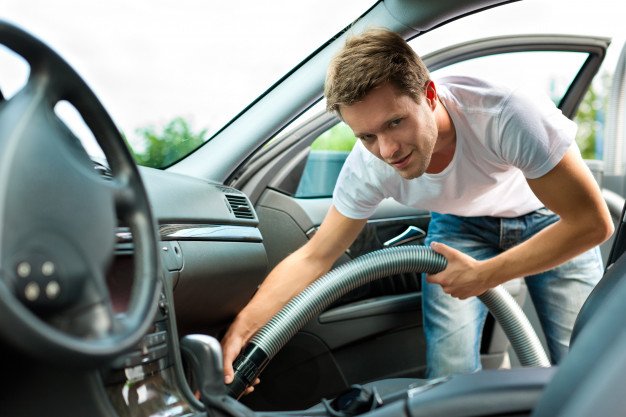
ALERT – All Locations, last updated March 13, 2020
As of 3/16/2020 all POV shipments for DOD uniformed personnel and civilian personnel are now suspended until further notice. Service members can still turn in their POVs at a VPC, however, an Exception to Policy must be provided at the time of turn in. Any POV turned in will be moved on to final destination once the travel ban is lifted. Visit PCSmyPOV for the latest information.
By USAG Ansbach Public Affairs
Now is the peak season for the Vehicle Processing Centers.
Although the VPC staff is busier than normal, this doesn’t mean the turn-in inspection standards have relaxed at all. Those standards, which follow regulations from the U.S. Environmental Protection Agency, the U.S. Department of Transportation and the U.S. Department of Agriculture, are all part of the VPC’s meticulous and precise inspection process.
Cleaning the interior
Starting at the front of the vehicle’s interior, move the front seats as far back as they will go, take out the floor mats and vacuum the floor thoroughly. Take a brush and sweep along the groove of the door jambs, not roughly but smoothly. With a flashlight, examine the sides of each seat, and then in and around the middle console. Inspect those places for any debris, dirt, pet hair, plant detritus, old food, coins, gum, trash and anything else. Repeat that process beneath the seats and then vacuum beneath the seats.
Clean and vacuum the floor mats. Once finished, place them back in the vehicle and assure that they are dry. Wipe down all hard surfaces with a damp cloth. Move the front seats all the way forward and repeat for the backseat rows and any other extra seat rows as applicable. Vacuum the trunk area and wipe down hard surfaces with a damp cloth. Assure this area is dry. Remove the spare tire to wipe down the compartment, and then wipe down the spare tire. Place the spare tire back into the compartment when finished. Assure compartment is dry.
Some vehicles such as SUVs and vans have back windows that can flip up or out. These can develop mold or mildew, which needs to be eliminated before shipment. Assure window seals are free of debris.
Wipe down and clean door frames to eliminate debris. Wipe down wheel wells, at least where your palm can reach with a cloth.
Cleaning the engine compartment
Shortly before arriving to the VPC for an inspection is the best time to inspect and clean the engine compartment. Once again, use the flashlight to inspect it and check for leaks. Vacuum out any pine needles, dirt, dead bees, seeds, etc., and either wipe it off or wash it off.
EPA and DOT stickers
Ensure the EPA emissions sticker is present and intact. Look for the words “Vehicle Emissions Control” to the word “Catalyst.” This sticker is a must, and its absence will result in the vehicle’s rejection during the inspection. The DOT sticker is located on the driver’s side doorframe or in the engine compartment. This is also known as the MFD, or Manufacturer’s Datasheet, and will include the date of manufacture and the vehicle identification number as well as indicating vehicle safety standards. “If this sticker is missing, or illegible, proof in the form of a stateside title (must state that the vehicle meets DOT requirements), stateside registration, or CARFAX report (www.carfax.com) must be provided to the VPC on the date of turn-in before your car can be accepted”states the turn-in section of the PCS My POV website.
Correcting technical faults
Emergency brakes must be working, contractors will apply the emergency brake and give the car a bit of gas just to check if it’s working. If the car doesn’t drive forward or in reverse it’s good to go.
Ensure no fluids are leaking from the vehicle, including anti-freeze and oil.
Though the battery may still start the vehicle, if it’s getting old, it may be time to replace it. When a battery dies in transit, that leads to extra work on the part of contractors and delays during shipment.
Pre-inspection
A customer who is a couple of days from turning in his or her vehicle for inspection, for example, can request that a VPC inspector take a quick look at the vehicle. After the pre-inspection, customers can be given an inspection sheet that lists any failures. That way when the customer returns, those problems can be already taken care of. The pre-inspection does not eliminate the main inspection at time of turn in. Due to the peak season, VPC personnel have limited time, so they perform quick looks on a case-by-case basis.
Damage inspection
After the agricultural inspection is the damage inspection during which contractors record nontechnical defects such as scratches, dents and rust.
